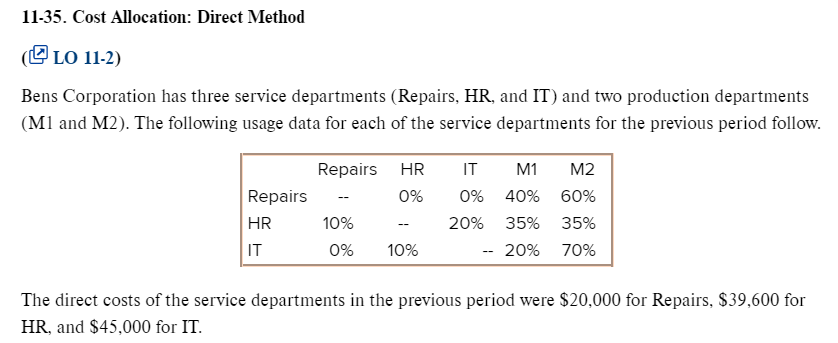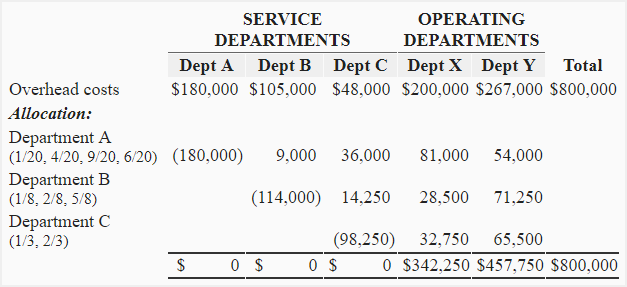
Martin’s Management Accounting Textbook: Chapter 6

With this information, you can determine which areas of your business need improvement and how changes in production will affect overall profitability. Cost allocation can also show you which departments or products are spending too much money on indirect expenses, and which ones aren’t using enough of them. This enables you to make more informed staffing decisions in the future based on how your company’s needs change over time.
Cost Allocation Methods
Pull allocations work in the opposite direction, using actual or expected output or resource consumption data to allocate costs. In this method, costs are “pulled” from the resources or activities to the specific products or services based on the resources consumed or services provided. Activity-Based Costing (ABC) is a method that allocates overhead and indirect costs based on activities that drive those costs.
- These systems can handle complex calculations, track resource usage in real-time, and generate detailed reports, significantly reducing the administrative burden on financial managers.
- Rate-Based ABC improves cost accuracy by directly linking resource consumption to established rates, making it especially useful in environments with stable, repeatable processes.
- The goal is to distribute costs in a manner that all departments or units perceive as just.
Managing Your Risk: Innovation to Control Risk in Employee Health Benefits & Business Insurance
All of our content is based on objective analysis, and the opinions are our own. For example, suppose your company produces two products, products A and B. These entries reduce cost of goods sold by $75 which is the net amount received from the by-product sales. She explains how data can work for business people without all the tech jargon. She is always on the look out for new ways data is being used by business people to know more and be sustainable.

Do you already work with a financial advisor?
Cost allocation in accounting is a critical practice that helps organizations assign costs to departments, products, or services to better understand profitability, resource use, and efficiency. The direct allocation of costs clearly identifies which specific objects are incurring the costs. This transparency can help in decision-making, as it allows for a better understanding of the cost structure and facilitates the identification of cost-saving opportunities. This figure is the total direct cost of the production of the goods or services and shows how much it costs to produce. This cost aggregation is critical in establishing the prices that can cover the costs and at the same time provides the desired profits. Variable costs fluctuate with your business activity and market conditions, rising and falling as your operations change.
For instance, a small consulting firm might allocate administrative costs directly to client projects based on billable hours, providing a straightforward way to manage expenses. A comprehensive understanding of cost structure begins with recognizing the various elements that contribute to a company’s overall expenses. These components can be broadly categorized into fixed and variable costs. Fixed costs remain constant regardless of production levels, such as rent, salaries, and insurance. On the other hand, variable costs fluctuate with production volume, including raw materials, utilities, and direct labor. This distinction is fundamental for budgeting and forecasting, as it helps businesses anticipate how changes in production levels will impact their financial health.
Q: How long does the negotiation process typically take?
This often results in reliance on estimates or averages, which can distort the true cost structure and profitability of different segments. In push allocations, costs are “pushed” down from a central pool (such as a centralized IT department or the management office) to specific cost centers or products. This method is useful when distributing indirect costs such as rent, utilities, or administrative expenses. For example, if a product requires frequent quality inspections, it will be allocated a higher share of inspection costs.
Direct costs play a significant role in shaping a company’s financial statements, particularly the income statement and balance sheet. On the income statement, direct costs are typically recorded as part of the cost of goods sold (COGS). This figure is subtracted from total revenue to determine the gross profit, a key indicator of a company’s profitability. Accurate tracking and allocation of direct costs ensure that the gross profit reflects the true financial performance of the core business operations. For instance, a manufacturing firm that meticulously tracks its direct material and labor costs can better assess its production efficiency and profitability. Another important aspect of indirect costs is their impact on budgeting and forecasting.
However, it can be more complex to implement and requires a thorough understanding of departmental interactions. The Assembly Department manager is likely to complain that neither of the allocations in Exhibit 6-11 is equitable. He or she might logically argue that the dual rate method illustratedabove assigns the Power Department’s idle capacity costs to the Assembly Department. These idle capacity costs will in turn be allocated to the AssemblyDepartment’s products. Using a single budgeted rate, rather than either a single actual rate or dual rate (Exhibit 6-11) will normalize the service costsallocations, provide more timely costing and aid in evaluating the service departments.
Conceptually, this is the same logical argument discussed inChapter 4 under the heading of reasons for using a predetermined overhead rate. Cost allocation allows you to determine where costs can be reduced and provides accurate reporting on company financials based on its relative performance. Allocating indirect expenses is also important for decision-making purposes.
The allocation of cost pools across different departments or products is driven by these cost drivers. In essence, cost drivers provide the linkage between the collected costs idnotify identity theft protection review (cost pools) and the segments to which those costs are assigned. They provide a consistent basis for distributing costs in the cost pool to the relevant cost objects.
This iterative approach can help organizations continuously improve their cost allocation practices as they gain more insights into their cost drivers and resource usage. Rate-Based ABC is a variation of Activity-Based Costing that assigns costs to products or services based on predefined rates for each activity. In this method, activities like machine operation, labor hours, or facility usage are assigned a cost rate, which is then multiplied by the actual consumption of the activity to determine the total cost. Allocated costs are usually expenses that have been divided among different cost objects, such as departments or products.
